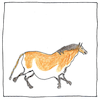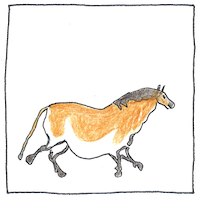Palaeolithic people
archaeology

|
Pigment
Red Ochre, 99,000-64,000 BCE At Blombos Cave in South Africa, people gathered and ground hematite, broke bones and boiled them for their fat, and mixed fat and powder in large abalone shells. We painted everything red, red like life and death, our tools, our clothes, our bodies life and death, birth and blood, to observe our births, and mourn our deaths. Yellow Ochre, 23,000-13,000 BCE In the caves of Spain and France during the Upper Palaeolithic, people painted animals and themselves on the walls using black, burnt umber, red and yellow ochres. We painted horses, stags, bison, and bulls, by blowing colors out of tubes. Wild and dangerous, running though our lives they’re also moving through our dreams.
Cultures
Bone, shell, wood, leather, fiber, and stone— religion, culture, music (drums, flutes), art, tools, mining, manufacture, and trade. Oldowan, Madrasian, Soanian, Acheulean, and Clactonian, Mousterian, Aterian, and Micoquien, Emiran, Bohunician, Ahmarian, Chätelperronian, Lincombian-Ranisian-Jermanowician, Aurignacian, Khormusan, Baradostian, Périgordian, Gravettian, Antelian, Mal’ta-Buret’, Solutrean, Halfan, Afontova Gora, Epigravettian, Zarzian, Iberomaurusian, Kebaran, Magdalenian, Trialetian, Hamburg, Eburran, Qadan, Sebilian, Natufian, Federmesser, Ahrensberg, and Swiderian. Let’s not be deceived by our distance from these people. They were clearly as intelligent and interesting as us and possibly more diverse.
Pigmented
The soul is only a blend of colors— white for purity, peace, and death, red for blood, war, and valor, blue for sincerity and happiness, yellow for happiness, green for growth and abundance, purple for reverence and nature, and black for power. Because everything today has color— Hello Kitty, Sherwin Williams, Fruit Loops— one may not realize its power. Colors themselves move the soul to paint everything else in their light.



Among the First Nations of Canada and the United States, the symbolic meaning of colors varied widely. The attributions that I give are derived from usage on totem poles by Northwest Coast cultures.
See also in The book of science:
Readings in wikipedia:
Other readings: